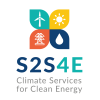Two new hydrological indicators are now available on the DST, the snow max anomaly and inflow anomaly, bringing added value to the tool for the hydropower sector.
The latest version of the S2S4E Decision Support Tool (DST v1.4.0), which was released on the 20th of April 2020, includes two new hydrological indicators developed by the Swedish Meteorological and Hydrological Institute (SMHI). These indicators are the snow max anomaly and inflow anomaly, and bring added value to DST forecasts for the hydropower sector.
Hydropower operators typically rely on climatological forecasts, observations and local hydrological model predictions for decision making. However, climatological forecasts are based on past observations and are thus unable to predict anomalies and extreme events.
The DST provides the hydropower sector with more dynamic seasonal forecasts and more accurate predictions on the snow coverage and inflow rate, helping them plan their operations more efficiently.
The two indicators are defined as follows:
- Snow max anomaly reflects the maximum amount of water stored as snow during winter. It is a measure of the natural storage and the seasonal redistribution of precipitation and inflow. A change in the snow storage may affect the need for storage capacity in reservoirs.
- Inflow anomaly indicates anomalous inflows in relation to a reference period. It indicates the inflow of water to reservoirs as a result of snow water runoff, driven by precipitation and temperature. This information is of particular interest in basins where other characteristics are favourable for hydropower, such as high inflow, large elevation differences and good storage capacity.
At an S2S4E webinar held on the 23rd of April 2020, Ilias Pechlivanidis (SMHI) discussed how these indicators are calculated. The webinar video is now available in the dedicated S2S4E webinar series page.
Written by Andria Nicodemou (BSC).


